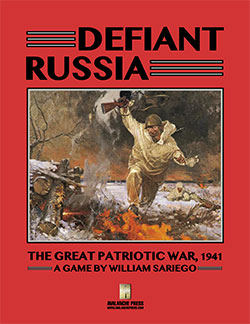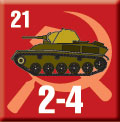| Defiant Russia:
Soviet Tank Corps, Part Two
By Mike Bennighof, Ph.D.
May 2024
 The huge armored force demanded by the Soviet General Staff (STAVKA) in early 1941 had no chance of becoming operational by the time the Germans attacked in June. Tank crews needed more time to train, divisions needed time to exercise, and factories needed time to turn out the needed tanks, soft vehicles, ammunition and spare parts. The huge armored force demanded by the Soviet General Staff (STAVKA) in early 1941 had no chance of becoming operational by the time the Germans attacked in June. Tank crews needed more time to train, divisions needed time to exercise, and factories needed time to turn out the needed tanks, soft vehicles, ammunition and spare parts.
The Red Army had sufficient modern tanks (KV and T-34 models) to equip about three tank corps in June 1941, but instead spread these over a number of formations and mixed them with older tanks. Likewise, enough experienced cadres existed to man probably half of the divisions formed and train their new recruits.
But that’s not what happened; instead the Red Army of Workers and Peasants opened the Great Patriotic War with its armored resources spread thin. Here’s a look at the rest of the 1941 Tank Corps as portrayed in our Defiant Russia game; the others were covered in Part One.
Kiev Special Military District
  
Fourth Tank Corps (8th and 32nd Tank Divisions, 81st Motorized Division) had more modern tanks than any other tank corps, and 8th Tank Division was the best-trained of the tank divisions and one of only two to have conducted division-scale exercises. While its sister division had plenty of new tanks as well, it had only been organized in the spring and lacked junior officers and NCOs as well as transport vehicles. Even so, 4th Tank Corps held together and fought well in the summer battles, and its divisions were eventually converted into tank brigades.
Eighth Tank Corps (12th and 34th Tank Divisions, 7th Motorized Division) had all of the Red Army’s old T35 heavy tanks, but as it also had a good collection of modern tanks it has a T34 icon on its playing piece. The corps moved immediately forward into a flank attack against the advancing panzers, but German air attacks crippled the corps artillery, expertly targeting the irreplaceable heavy tractors that towed the big guns. By August the divisions had been disbanded to form new tank brigades.
Ninth Tank Corps (20th and 35th Tank Divisions, 131st Motorized Division) had no modern tanks and few older ones, but survived the initial German onslaught as its divisions were stationed away from the frontier. After fighting as battle groups throughout the summer, the tank divisions were disbanded while the motorized division was wiped out fighting on foot.
  
Fifteenth Tank Corps (10th and 37th Tank Divisions, 212th Motorized Division) had the Red Army’s other well-trained tank division, the 10th. The corps’ new tank division had plenty of tanks and enlisted men, but less than half of its needed junior officers and NCOs. The corps fought well, particularly the 10th Tank Division, and survived the summer battles to be converted into tank brigades.
Sixteenth Tank Corps (15th and 39th Tank Divisions, 240th Motorized Division) had no modern tanks, but was not in the front lines on June 22nd and survived to fight on through the summer. Its tank divisions were disbanded after the summer battles, while the motorized division was dismounted and fought on as a standard rifle division.
Nineteenth Tank Corps (40th and 43rd Tank Divisions, 213th Motorized Division) had only been formed in the spring; 40th Tank Division had been pieced together from the tank battalions assigned to rifle divisions, and was soon broken up with its battalions sent back to help the infantry. The 43rd Tank Division had an experienced cadre with many Winter War veterans, and formed a mobile group that fought on through the summer before becoming a tank brigade.
 
Twenty-Second Tank Corps (19th and 41st Tank Divisions, 215th Motorized Division) showed the same signs of too-rapid expansion: plenty of enlisted troops, over-aged light tanks and artillery pieces, not nearly enough junior officers, NCOs, modern tanks or heavy artillery-hauling tractors. The 41st Tank Division had just unloaded 31 brand-new KV-II heavy tanks when the Germans attacked, but their ammunition had not yet arrived. The motorized division was destroyed within days, but the tank divisions fought on through the summer when they were disbanded.
Twenty-Fourth Tank Corps (45th and 49th Tank Divisions, 216th Motorized Division) had only just been formed in March, and lacked just about everything it needed to become an efficient unit. Nevertheless, it went into battle against the Germans within hours of the attack, and by August it no longer existed.
Odessa Military District
 
Second Tank Corps (11th and 16th Tank Divisions, 15th Motorized Division) had started to receive modern tanks, but still had mostly light tanks taken from infantry support battalions when the war began. Facing Romanian units ill-equipped to meet armor, the corps survived through the summer until its tank divisions were disbanded in September and the motorized division became a rifle formation.
Eighteenth Tank Corps (44th and 47th Tank Divisions, 218th Motorized Division) had no modern tanks, and shortages of just about everything else. It also fought the Romanians, surviving to be converted into new tank brigades in September.
Elsewhere
  
Fifth Tank Corps (13th and 17th Tank Divisions, 109th Motorized Division) had been formed in the Trans-Baikal Military District in Siberia and was on its way to the Kiev Military District when the Germans attacked. Its three divisions fought separately, and by late July the tank divisions were no more and the motorized division had been dismounted and converted to a rifle division.
Seventh Tank Corps (14th and 18th Tank Divisions, 1st Moscow Motorized Division) had the splendid 1st Moscow Motorized Division, which soon justified its pre-war status as the Red Army’s showpiece unit. The two tank divisions were significantly less splendid, with only aged light tanks, and by August both had been disbanded.
Twenty-First Tank Corps (42nd and 46th Tank Divisions, 185th Motorized Division) formed in the Moscow Military District in the spring of 19441 and had only started receiving tanks in early June. It went into action anyway, with the two tank divisions forming brigade-sized armored battle groups equipped with elderly light tanks, supporting the “motorized” division which fought on foot. The corps had been disbanded by August.
  
Twenty-Third Tank Corps (48th and 51st Tank Divisions, 220th Motorized Division) formed in the Orel Military District and was still there when the Germans attacked, immediately moving to the front to counter-attack. The corps had little of its necessary armor or other heavy equipment, and by July was no longer combat-effective.
Twenty-Fifth Tank Corps (50th and 55th Tank Divisions, 219th Motorized Division) also formed away from the borders, this time in the Khakov Military District, and like 23rd Tank Corps had very low priority for vehicle and weapon deliveries. It fought under Western Front around Smolensk, and by September its tank divisions had been disbanded.
Twenty-Sixth Tank Corps (52nd and 56th Tank Divisions, 103rd Motorized Division) had been left in the North Caucasus Military District when the rest of the units stationed there mobilized and headed west, thanks to its poor state of training and equipment. That didn’t stop the high command from ordering it into action against the Germans, where it lasted less than three weeks.
 
Twenty-Eighth Tank Corps (6th and 54th Tank Divisions, 236th Motorized Division) formed part of the garrison along the border with Turkey. It remained there until the autumn, when all three of its divisions were dissolved. In Defiant Russia there’s a chance that Turkey will enter the war against the Soviet Union, in which case the 28th Tank Corps will likely see action.
Thirtieth Tank Corps (58th and 60th Tank Divisions, 239th Motorized Division) began the war in the Far East, moving west in October along with a number of other “Siberian” formations (unlike the old Imperial Army, the Red Army had no “Siberian” designation). Lacking modern tanks but sporting a tough cadre of experienced troops, the tank divisions scored several successes against the Germans before its divisions were converted into tank brigades. The motorized division remained in the Far East.
You can order Defiant Russia (Playbook Edition) right here.
Defiant Package
Defiant Russia (Playbook)
Red Victory
Retail Price: $74.98
Package Price: $60
Gold Club Price: $48
You can experience the Defiant Package right here.
Sign up for our newsletter right here. Your info will never be sold or transferred; we'll just use it to update you on new games and new offers.
Mike Bennighof is president of Avalanche Press and holds a doctorate in history from Emory University. A Fulbright Scholar and NASA Journalist in Space finalist, he has published countless books, games and articles on historical subjects.
He lives in Birmingham, Alabama with his wife and three children. He misses his dog, Leopold. Leopold enjoyed biting sticks.
Want to keep Daily Content free of third-party ads? You can send us some love (and cash) through this link right here. You don’t have to, but Leopold would like it if you did.
|
